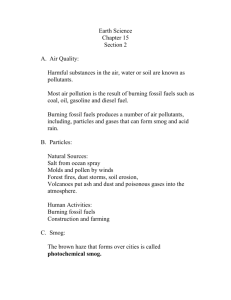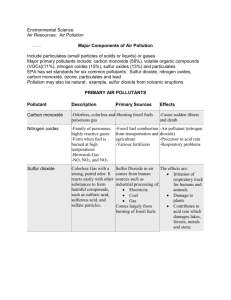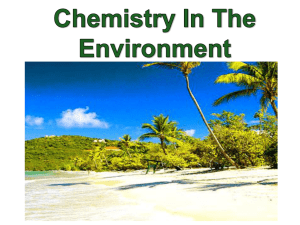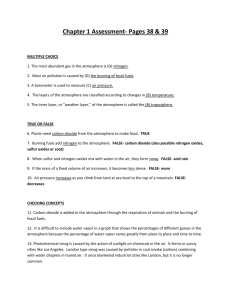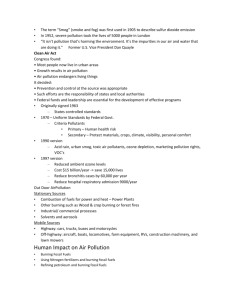Primary Air Pollutants Worksheet
advertisement
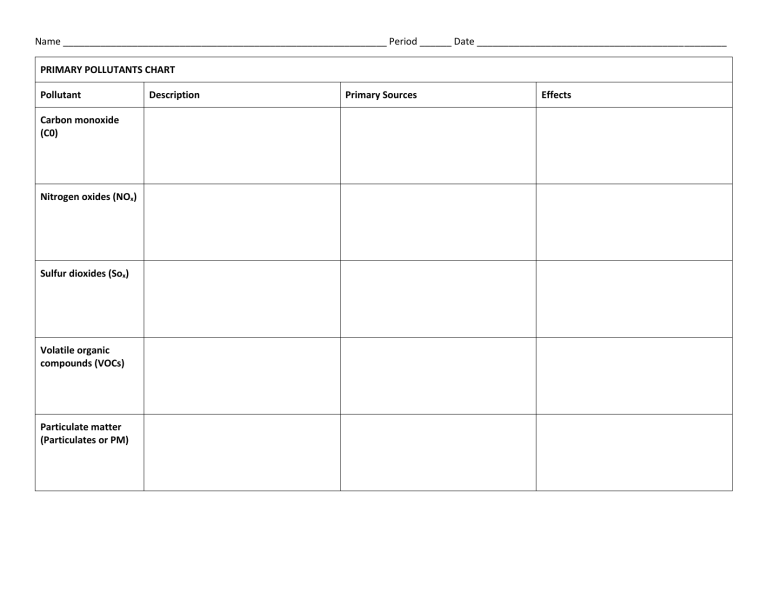
Name _____________________________________________________________ Period ______ Date _______________________________________________ PRIMARY POLLUTANTS CHART Pollutant Carbon monoxide (C0) Nitrogen oxides (NOx) Sulfur dioxides (Sox) Volatile organic compounds (VOCs) Particulate matter (Particulates or PM) Description Primary Sources Effects Cut these out and paste them in the Primary Pollutants Chart. comes from burning fuels in vehicles, power plants, and industrial boilers. is produced by chemical interactions between sulfur and oxygen. can make the body vulnerable to respiratory infections, lung diseases, and cancer, NOx contributes to the brownish haze seen over cities and to acid precipitation. When combustion (burning)temperatures exceed 538oC, nitrogen and oxygen combine to form nitrogen oxides. Most come from construction, agriculture, forestry, and fires. Vehicles and industrial processes also contribute particulates. come from burning fuels. Vehicles are a major source of VOCs. contributes to acid precipitation as sulfuric acid. Secondary pollutants that result from reactions with SO2 can harm plant life and irritate the respiratory systems of humans. can form clouds that reduce visibility and cause a variety of respiratory problems. Particulates have also been linked to cancer. As well, they may corrode metals and erode buildings and sculptures. Sources of are cars, trucks, buses, small engines, and some industrial processes. contribute to smog formation and can cause serious health problems, such as cancer. They may also harm plants. comes mostly from burning fossil fuels. are tiny particles of liquid or solid matter. are organic chemicals that vaporize readily and form toxic fumes. interferes with the blood’s ability to carry oxygen, slowing reflexes and causing drowsiness. In high concentrations, CO can cause death. is an odorless, colorless, poisonous gas. It is produced by the incomplete burning of fossil fuels. Answers PRIMARY POLLUTANTS CHART Pollutant Description Primary Sources Effects Carbon monoxide (C0) is an odorless, colorless, poisonous gas. It is produced by the incomplete burning of fossil fuels. Sources of are cars, trucks, buses, small engines, and some industrial processes. interferes with the blood’s ability to carry oxygen, slowing reflexes and causing drowsiness. In high concentrations, CO can cause death. Nitrogen oxides (NOx) When combustion (burning)temperatures exceed 538oC, nitrogen and oxygen combine to form nitrogen oxides. comes from burning fuels in vehicles, power plants, and industrial boilers. can make the body vulnerable to respiratory infections, lung diseases, and cancer, NOx contributes to the brownish haze seen over cities and to acid precipitation. Sulfur dioxides (Sox) is produced by chemical interactions between sulfur and oxygen. comes mostly from burning fossil fuels. Volatile organic compounds (VOCs) are organic chemicals that vaporize readily and form toxic fumes. come from burning fuels. Vehicles are a major source of VOCs. contribute to smog formation and can cause serious health problems, such as cancer. They may also harm plants. Particulate matter (Particulates or PM) are tiny particles of liquid or solid matter. Most come from construction, agriculture, forestry, and fires. Vehicles and industrial processes also contribute particulates. can form clouds that reduce visibility and cause a variety of respiratory problems. Particulates have also been linked to cancer. As well, they may corrode metals and erode buildings and sculptures. 6 contributes to acid precipitation as sulfuric acid. Secondary pollutants that result from reactions with SO2 can harm plant life and irritate the respiratory systems of humans. 15

